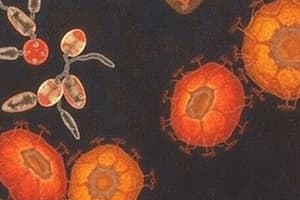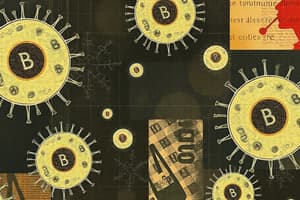Podcast
Questions and Answers
What is the primary function of immunoglobulin A (IgA)?
What is the primary function of immunoglobulin A (IgA)?
- Mediates allergic responses
- Provide mucosal immunity (correct)
- Activate complement pathways
- Neutralize bacterial toxins
Which immunoglobulin is primarily involved in allergic reactions and defense against parasitic infections?
Which immunoglobulin is primarily involved in allergic reactions and defense against parasitic infections?
- IgE (correct)
- IgD
- IgG
- IgM
Which of the following statements about IgM is true?
Which of the following statements about IgM is true?
- It is the most abundant antibody class.
- It can cross the placenta.
- It indicates intrauterine infection if present in newborns. (correct)
- It is mainly found in mucosal secretions.
What role do Fc receptors play in the immune response?
What role do Fc receptors play in the immune response?
Which immunoglobulin functions mainly as a B cell receptor?
Which immunoglobulin functions mainly as a B cell receptor?
What are antibodies primarily produced in response to?
What are antibodies primarily produced in response to?
Which technique is used to separate proteins in serum for antibody detection?
Which technique is used to separate proteins in serum for antibody detection?
What is the primary function of B cells in antibody production?
What is the primary function of B cells in antibody production?
What does the constant region of an antibody determine?
What does the constant region of an antibody determine?
Which part of the antibody interacts with the antigen?
Which part of the antibody interacts with the antigen?
What are the hypervariable regions of an antibody responsible for?
What are the hypervariable regions of an antibody responsible for?
Which of the following classes of antibodies is not one of the five main classes?
Which of the following classes of antibodies is not one of the five main classes?
How many polypeptide chains make up an antibody?
How many polypeptide chains make up an antibody?
What are the two types of chains found in antibodies?
What are the two types of chains found in antibodies?
What is the role of membrane-bound antibodies?
What is the role of membrane-bound antibodies?
Which immunoglobulin class has subclasses and is involved primarily in secondary immune responses?
Which immunoglobulin class has subclasses and is involved primarily in secondary immune responses?
Which IgG subclass has the shortest half-life?
Which IgG subclass has the shortest half-life?
What percentage of total IgG does IgG1 represent?
What percentage of total IgG does IgG1 represent?
Which type of antibody is the first to be secreted during an immune response?
Which type of antibody is the first to be secreted during an immune response?
Which IgG subclasses are known to bind to Staphylococcal Protein A?
Which IgG subclasses are known to bind to Staphylococcal Protein A?
What is a unique feature of IgA compared to other immunoglobulins?
What is a unique feature of IgA compared to other immunoglobulins?
Flashcards
Antibody
Antibody
Glycoproteins produced by vertebrates in response to antigens.
Antigen
Antigen
Substances that trigger antibody production and are recognized by antibodies.
Serum Protein Electrophoresis (SPE)
Serum Protein Electrophoresis (SPE)
A lab technique to separate serum proteins by size and charge, aiding diagnosis.
Antibody Class
Antibody Class
Signup and view all the flashcards
Antibody Structure
Antibody Structure
Signup and view all the flashcards
Variable Region (Antibody)
Variable Region (Antibody)
Signup and view all the flashcards
Constant Region (Antibody)
Constant Region (Antibody)
Signup and view all the flashcards
Antigen-binding site
Antigen-binding site
Signup and view all the flashcards
Complementarity Determining Regions (CDRs)
Complementarity Determining Regions (CDRs)
Signup and view all the flashcards
IgG subclasses
IgG subclasses
Signup and view all the flashcards
Immunoglobulin G (IgG)
Immunoglobulin G (IgG)
Signup and view all the flashcards
Immunoglobulin M (IgM)
Immunoglobulin M (IgM)
Signup and view all the flashcards
Heavy Chains
Heavy Chains
Signup and view all the flashcards
Light Chains
Light Chains
Signup and view all the flashcards
Antigen Binding
Antigen Binding
Signup and view all the flashcards
IgM Pentamer
IgM Pentamer
Signup and view all the flashcards
IgA - The Mucosal Defender
IgA - The Mucosal Defender
Signup and view all the flashcards
IgE - The Allergy & Parasite Fighter
IgE - The Allergy & Parasite Fighter
Signup and view all the flashcards
IgD - The B Cell Receptor
IgD - The B Cell Receptor
Signup and view all the flashcards
Fc Receptors - Antibody Mediators
Fc Receptors - Antibody Mediators
Signup and view all the flashcards
Study Notes
Antibodies
- Antibodies are glycoproteins found in vertebrates.
- They are produced in response to foreign structures called antigens.
- Antigens are substances that trigger the production of antibodies.
- Antibodies recognize and bind to specific antigens.
Detection of Antibodies in Human Serum
- Serum Protein Electrophoresis (SPE) is a lab technique.
- It separates serum proteins based on size and charge.
- SPE helps diagnose conditions by analyzing protein patterns.
- Antibodies are typically found in the gamma globulin fraction of serum.
Production of Antibody
- B cells differentiate into plasma cells after stimulation.
- Plasma cells secrete antibodies, which are also called immunoglobulins.
- Immunoglobulins mediate humoral immunity.
- The process involves binding to antigen, chemical signals from helper T cells, becoming plasma cells and releasing antibodies.
Antibody
- Gamma globulin proteins react with antigens.
- These antigens stimulated their production.
- Antibodies make up 20% of plasma protein.
- Five classes of antibodies exist: IgG, IgM, IgA, IgD, and IgE.
- These classes differ based on heavy chain differences.
Structure of Antibody
- Antibodies have a Y-shaped structure.
- They consist of four polypeptide chains: two heavy chains and two light chains.
- The chains are linked by disulfide bonds for stability.
- Variable regions of the Y bind to specific antigens.
- The constant region determines the antibody class and its function in the immune response.
Definitions of Fc and Fab Regions
- The antigen binding fragment (Fab) recognizes antigens.
- The crystallizable fragment (Fc) interacts with immune system components.
Antibody-Binding Site
- Within the variable domains, there are three regions with extreme variability.
- These highly variable regions are called hypervariable regions.
- These regions contact antigens directly.
- They form the antigen binding site.
- The regions are also referred to as complementarity-determining regions or CDRs.
Variable Regions of Antibodies (Complementarity Determining Regions - CDRs)
- CDR's in light and heavy chains of antibodies are highly variable.
- These are essential for antigen binding.
Binding of an Antigen by an Antibody
- Antibodies bind to antigens using their CDRs.
- This binding involves precise interactions between antibody and antigen structures.
Flexibility of Antibody Molecules Via Hinge Region
- Antibodies have flexibility via the hinge region.
- This flexibility allows for the antibody to bind to antigens in different orientations.
Enzymatic Digestion of Antibodies
- Enzymes like papain and pepsin can digest antibodies.
- Papain cleaves antibodies into Fab fragments and Fc fragments.
- Pepsin cleaves antibodies into F(ab')2 fragments.
Membrane-bound and Secreted Antibodies
- Membrane-bound antibodies are critical for B cell activation.
- B cells are activated when membrane-bound antibodies bind to specific antigens.
- This interaction triggers B cell proliferation and differentiation.
Types of Heavy and Light Chains in Antibodies
- Antibodies have various types of heavy chains (gamma, alpha, mu, epsilon, delta).
- Antibodies also have kappa and lambda light chains.
Classes and Subclasses of Immunoglobulins
- IgG, IgM, IgA, IgD, and IgE are the major classes of immunoglobulins.
- Subclasses of immunoglobulins differ based on the heavy chain's structure.
Immunoglobulin G (IgG)
- IgG is the most abundant antibody in serum.
- It’s important in secondary immune responses.
- It provides long-term immunity.
- Most subclasses can cross the placenta; important in maternal immunity to the newborn.
- IgG participates in complement fixation, precipitation, and neutralization of viruses and toxins.
IgG Subclasses
- IgG has four subclasses with differences in half-life, concentration, binding to antigens, transfer across the placenta, Fc binding and complement fixation.
Immunoglobulin M (IgM)
- IgM is the first antibody secreted in an immune response.
- It's crucial in primary immune responses, serving as a critical early immune response.
- IgM is the most important cell surface antibody.
- IgM is not transported across the placenta.
- High IgM levels in newborns raise concerns for intrauterine infections.
Immunoglobulin A (IgA)
- IgA is more abundant than other antibody classes.
- It's major in mucosal areas and secretions.
- IgA provides crucial mucosal immunity.
- IgA exists in dimeric form, with important secretory components enabling transport through mucosal surfaces.
Immunoglobulin E (IgE)
- IgE is involved in allergic reactions and defense against parasitic infections.
- Low levels of IgE in serum, present on surfaces of mast cells and basophils, enabling these cells to release inflammatory mediators during allergic responses.
Immunoglobulin D (IgD)
- IgD functions mainly as a B cell receptor.
- IgD has a transmembrane region.
Fc Receptors
- Fc receptors are proteins on various cell surfaces that bind to the Fc portion of antibodies.
- These receptors' activation triggers various cellular functions and regulates the immune response.
Functions of Antibodies
- Antibodies neutralize toxins and viruses.
- Antibodies opsonize microbes, facilitating phagocytosis.
- Antibody-dependent cell-mediated cytotoxicity (ADCC) eliminates target cells.
- Antibodies activate complement to prevent microbes from attaching to mucosal surfaces.
- Antibodies mediate complement-dependent cytotoxicity (CDC).
Studying That Suits You
Use AI to generate personalized quizzes and flashcards to suit your learning preferences.



![Lecture 05: Antibody Production and Adaptive Immunity [SEQ 2]](https://assets.quizgecko.com/cdn-cgi/image/width=300,height=200,fit=crop,quality=75,format=webp/quiz/f58dc4dbf6c4223e9570af009a23110d.jpg)
